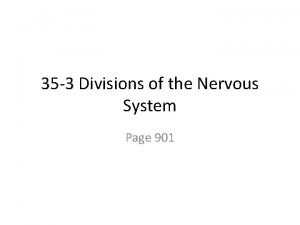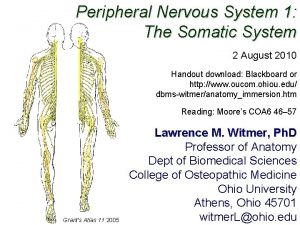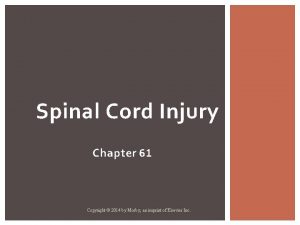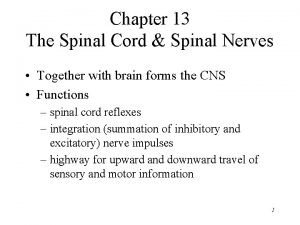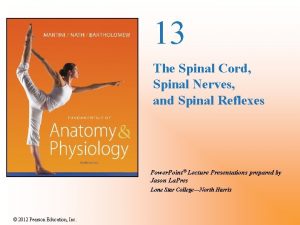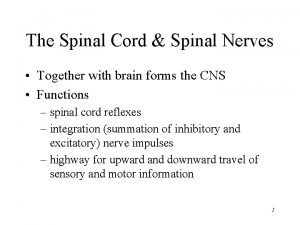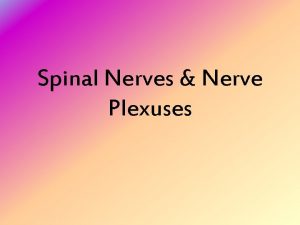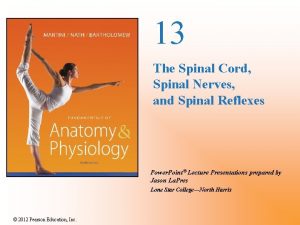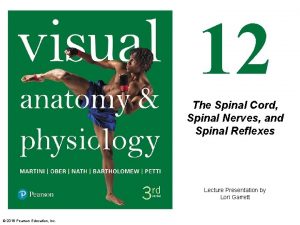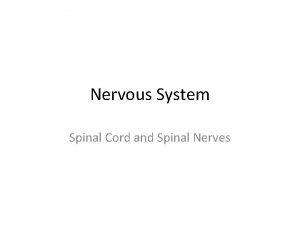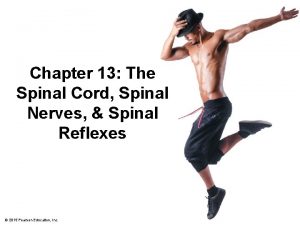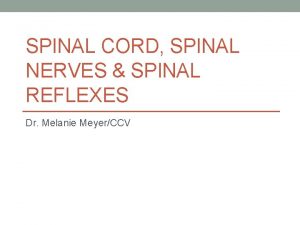Ch 14 Spinal Cord and Spinal Nerves Explain















- Slides: 15

Ch 14: Spinal Cord and Spinal Nerves Explain spinal cord anatomy, including gray and white matter and meninges (give the general functions of this organ). Discuss the structure and functions of the spinal nerves and plexuses. Describe the structural components of reflexes.

Adult spinal cord: Resides inside vertebral canal Extends to L 1/ L 2 31 segments, each associated with a pair of dorsal root ganglia Two enlargements

1. Cervical Enlargement Gray matter expanded to incorporate more sensory input from limbs and more cell bodies for motor control of limbs

Spinal Meninges Three membranes surround all of CNS 1) Dura mater - "tough mother", strong 3) Pia mater 2) Arachnoid meninx spidery looking, carries blood vessels, etc. Subarachnoid space 3) Pia mater - "delicate mother", adheres tightly to surface of spinal cord 1) Dura mater

Inferior End of Spinal Cord Conus medullaris - inferior end of spinal cord proper Cauda equina - individual spinal nerves within spinal canal Filum terminale - filamentous end of meninges, "tie-down"

Lumbar Puncture (= Spinal Tap) L 3 L 4 For clinical examination of CSF or administration of radiopaque dyes, drugs and sometimes anesthetics However: mostly “epidurals” for anesthetics

Organization of Cord Cross Section Gray matter - interior horns posterior - somatic and visceral sensory nuclei anterior (and lateral) gray horns – somatic and visceral motor control gray commissures - axons carrying information from side to side White matter - tracts or columns posterior white column anterior white column lateral white column anterior white commissure functions ascending tracts - sensory toward brain descending tracts - motor from brain Fig 14 -5

Peripheral Nerves Definition: bundles of axons. AKA tracts in CNS Organization – coverings: Epineurium wraps entire nerve Perineurium wraps fascicles of tracts Endoneurium wraps individual axons

Anatomy of a Peripheral nerve Function: sensory - afferent motor - efferent mixed - contains axons of both

Organization of Spinal Nerves: 1. Root – inside vertebral canal a. dorsal sensory root with a ganglion 1. b. ventral motor 2. Mixed spinal nerve Fig 14 -7 3. Rami a. dorsal - mixed to skin and muscles of back b. ventral - mixed “spinal nerve” to ventrolateral body surfaces and limbs c. white ramus communicans motor ANS d. gray ramus communicans motor ANS

Dermatomes Sensory innervations by specific spinal nerves Each pair of spinal nerves monitors specific region of body surface. Clinical significance ?

4 Principal Plexuses Braids of ventral rami of cervical, thoracic, lumbar or sacral spinal nerves Cervical Plexus Phrenic nerve - innervates diaphragm

Brachial Plexus Musculocutaneous nerve - innervates biceps and brachialis muscles Median nerve - innervates lateral flexors Ulnar nerve - innervates medial flexors Radial nerve - innervates forearm extensors study in lab!!

Reflexes Fast, stereotypical, inborn, protective actions Occur at spinal cord or brainstem levels May be either monosynaptic or polysynaptic All require a. stimulus at receptor b. sensory information relay c. processing at CNS level d. activation of motor response e. response of peripheral effector Examples?

Shingles Varicella-zoster virus ( of the herpes family) In dorsal root ganglia and cranial nerves Initial infection: chicken pox
 On occasion our trusty truck
On occasion our trusty truck Innervations of the brachial and lumbar enlargements
Innervations of the brachial and lumbar enlargements Inferior gluteal nerve
Inferior gluteal nerve Nerves branching beyond the spinal cord into the body
Nerves branching beyond the spinal cord into the body Spine meninges
Spine meninges Stretch reflex
Stretch reflex Spinal cord and brain
Spinal cord and brain Somatic nervous system
Somatic nervous system Somi brace
Somi brace Visceral reflex
Visceral reflex Function of spinal cord ppt
Function of spinal cord ppt External anatomy of spinal cord
External anatomy of spinal cord Nerve regions of the body
Nerve regions of the body Figure 13-2 spinal nerves
Figure 13-2 spinal nerves Spinal nerves
Spinal nerves The spinal nerves
The spinal nerves






